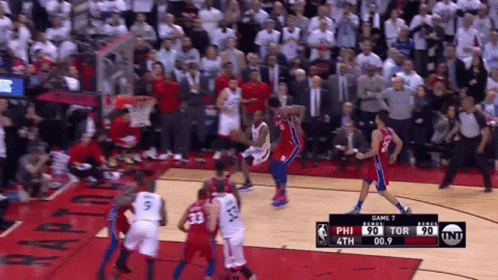Our Topic and Motivations
What is a game-winning buzzer-beater shot?
- A shot taken to win a game just before the final buzzer goes off.
Why study this specific type of basketball shot?
- Lets look at the crowd when such a shot is scored:
Introduce the data
This dataset is formatted such that each row represents one game-winning buzzer-beater shot made.
Each row contains information about the player who made the shot, the players’ names and teams, the date of the game, and various game-level statistics about the players (e.g. field goals, minutes played, etc.).
Note that older seasons in this dataset contain less information about game statistics thus tend to have more null values however these rows were kept for the other information they did provide
Highlights from EDA
Game Score range for players is between 10 and 20, with the peak being 15. There are more high-scoring buzzer-beater makers than low-scoring ones. Players who have higher game score, are more skilled and likely to score.
Successful unassisted shots tend to be made from closer range compared to successful assisted shots. Players with higher Game Scores are more likely to take shots from farther away. Chances of making a buzzer-beater shot increases with assists.
── Attaching packages ────────────────────────────────────── tidymodels 1.0.0 ──
✔ broom 1.0.2 ✔ recipes 1.0.6
✔ dials 1.1.0 ✔ rsample 1.1.1
✔ dplyr 1.1.2 ✔ tibble 3.2.1
✔ ggplot2 3.4.0 ✔ tidyr 1.2.1
✔ infer 1.0.4 ✔ tune 1.1.1
✔ modeldata 1.0.1 ✔ workflows 1.1.2
✔ parsnip 1.0.3 ✔ workflowsets 1.0.0
✔ purrr 1.0.0 ✔ yardstick 1.1.0
── Conflicts ───────────────────────────────────────── tidymodels_conflicts() ──
✖ purrr::discard() masks scales::discard()
✖ dplyr::filter() masks stats::filter()
✖ dplyr::lag() masks stats::lag()
✖ recipes::step() masks stats::step()
• Learn how to get started at https://www.tidymodels.org/start/
── Attaching packages ─────────────────────────────────────── tidyverse 1.3.2 ──
✔ readr 2.1.3 ✔ forcats 0.5.2
✔ stringr 1.5.0
── Conflicts ────────────────────────────────────────── tidyverse_conflicts() ──
✖ readr::col_factor() masks scales::col_factor()
✖ purrr::discard() masks scales::discard()
✖ dplyr::filter() masks stats::filter()
✖ stringr::fixed() masks recipes::fixed()
✖ dplyr::lag() masks stats::lag()
✖ readr::spec() masks yardstick::spec()
`geom_smooth()` using formula = 'y ~ x'
Warning: Removed 205 rows containing non-finite values (`stat_smooth()`).
Warning: Removed 205 rows containing missing values (`geom_point()`).
Inference/modeling/other analysis
Hypothesis 1: Players with higher average game scores across the games where they have made game winning buzzer-beater shots are those who have made more of these shots.
Joining with `by = join_by(player)`
Model: R^2 = 0.03, Chi-square test of Independence: p = 0.43
Inference/modeling/other analysis
Hypothesis 2: All predictor variables have no effect on the response variable (distance).
Warning: Using `size` aesthetic for lines was deprecated in ggplot2 3.4.0.
ℹ Please use `linewidth` instead.
`geom_smooth()` using formula = 'y ~ x'
Warning: Removed 205 rows containing non-finite values (`stat_smooth()`).
Warning: Removed 205 rows containing missing values (`geom_point()`).
R^2 = .107, p-values: 6.100504e-15 for GmSc, 9.1403964e-15 for Assist, and 0.03864903 for the interaction between GmSc and Assist
Conclusions + future work
Game Score vs. Number of Game Winning Buzzer-Beater Shots made:
- Game score is independent across different number of shots made
-Thus, game performance is not representative of a player’s ability to make a buzzer-beater shot
-Most likely linked to less quantifiable measures, such as a players’ ability to perform well under intense pressure
Factors that are associated with successful Buzzer-Beater Shots:
-Number of assists and game score were significant predictors of success
-Passing/teamwork’s role in success of shots
-Higher-performing players: more likely to make successful shots
-R-squared value of 0.107 -> Other significant factors, such as shooter’s skill level and defense’s positioning
Future Work:
-Applications to other sports (game-winning touchdowns in American football, overtime goals in ice hockey)



